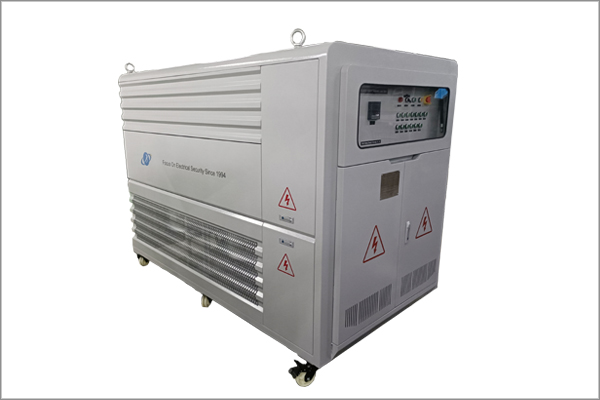Differences between AC Load Bank and DC Load Bank
Time:2025-06-30
In the field of power electronics, load banks are essential devices used to simulate actual loads for the testing, inspection, and maintenance of power supply equipment. AC load banks and DC load banks are two common types. Although they both serve the purpose of simulating loads, there are significant differences in working principles, application scenarios, structural features, and other aspects. A thorough understanding of these differences helps in the correct selection and use of load banks in practical applications, ensuring the stable operation of power systems.
In terms of working principles, AC load banks are mainly used to simulate the load conditions of AC power supplies and handle alternating current. Their internal components usually consist of resistors, inductors, and capacitors. Through the combination of these components, different types of AC loads can be simulated, such as resistive, inductive, and capacitive loads. These components are connected according to specific circuit topologies, enabling the adjustment of load impedance magnitude and phase according to actual needs to meet various testing requirements for AC power supplies. On the other hand, DC load banks are designed for DC power supplies and deal with direct current with a constant direction. The working principle of DC load banks is relatively simple, mainly relying on high-power resistors to consume the electrical energy of DC power supplies. By changing the resistance value connected to the circuit, the load magnitude of the DC power supply can be adjusted.
Regarding application scenarios, the two types of load banks have distinct divisions of labor. AC load banks are widely used in the testing and maintenance of AC power systems, such as AC generators, UPS (Uninterruptible Power Supply) systems, and frequency conversion equipment. For example, during the factory testing of AC generators, resistive load banks can simulate loads under different working conditions to detect parameters such as output voltage, frequency, and power of the generator under various load conditions, and evaluate the performance and stability of the generator. For UPS systems, AC load banks can test their load-carrying capacity and output characteristics when switching from mains power to battery power supply mode. DC load banks, however, are commonly used for testing DC power supply equipment, such as battery packs, DC regulated power supplies, and the DC side of solar photovoltaic inverters. In battery maintenance, DC load banks can simulate actual loads and conduct discharge tests on batteries. By monitoring the changes in voltage, current, and capacity during the discharge process, the health status and remaining capacity of the batteries can be determined, facilitating timely maintenance and replacement.
In terms of structural features, due to differences in working principles and application scenarios, AC load banks and DC load banks also vary. To handle alternating current, AC load banks need to consider phase changes caused by inductors and capacitors, as well as electromagnetic compatibility issues, so their structures are relatively complex. The layout and connection of internal components need to follow strict electromagnetic design specifications to reduce electromagnetic interference and ensure the accuracy of test results. In addition, AC load banks are usually equipped with more complex control and monitoring systems, which can real-time monitor and display various parameters of the AC power supply and automatically adjust the load according to test requirements. In contrast, the structure of DC load banks is relatively simple, mainly composed of high-power resistors and heat dissipation devices. Since there is no phase problem in direct current, the focus is on solving the heat dissipation and power-bearing capacity of the resistors. To ensure the stability of the resistors during long-term operation, DC load banks usually adopt efficient heat dissipation methods, such as forced air cooling or liquid cooling, to keep the resistor temperature within a reasonable range.
In terms of performance parameters, AC load banks and DC load banks also have their own characteristics. The key parameters of AC load banks include rated voltage, rated current, rated power, and power factor adjustment range. Among them, the power factor adjustment range is an important indicator of AC load banks, reflecting their ability to simulate different types of loads. For example, when testing some AC equipment with strict requirements for power factor, it is necessary to adjust the power factor of the AC load bank to simulate actual working conditions. The main performance parameters of DC load banks include rated voltage, rated current, rated power, and maximum discharge current. When selecting a DC load bank, the maximum discharge current is an important reference index, which determines the maximum load that the load bank can apply to the DC power supply and directly affects the scope and depth of the performance test of the DC power supply.
In conclusion, although both AC load banks and DC load banks belong to the category of load banks, there are many differences in working principles, application scenarios, structural features, and performance parameters. In actual power testing and maintenance work, only by fully understanding these differences can we select the appropriate load bank according to specific test objects and requirements, ensure the accuracy and reliability of test results, and provide strong support for the stable operation of power systems.
News Recommendation
-
 2024-09-11
2024-09-11TRIUMPH LOAD EXHIBITING AT Enlit Europe 2024 -BOOTH 7.H08
-
 2023-04-21
2023-04-21TRIUMPH LOAD EXHIBITING AT DATA CENTER WORLD GERMANY 2023-BOOTH F909
-
 2023-04-06
2023-04-06TRIUMPH LOAD EXHIBITING AT ELECTRIC POWER TECH KOREA 2023 – Booth G109
-
 2022-05-05
2022-05-05What is the role of ac load bank for power supply?
-
 2022-05-05
2022-05-05What is the role of the load bank?


